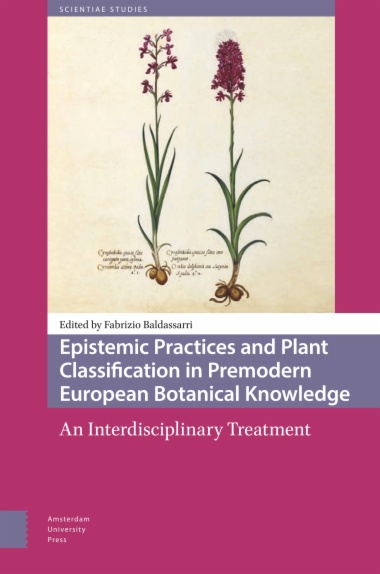This volume aims to uncover the diverse approach to plants in the Renaissance and seventeenth century that paved the way for a definition of botany as a fully-fledged discipline. Its scope expands beyond the natural historical interest in collections and the fabrication of materia medica: moving from Varchi, Matthioli and Bauhin to Locke, Pinelli, and Linnaeus, among others, the contributions collected here connect practical and theoretical features, dealing with the challenges that characterized any involvement with plants. The authors focus on the linguistic shortcomings, problems in authenticating specimens, and efforts to establish new botanical geographies to favour trades, as well as the pursuits of new methodologies, artisanal technologies, and chymical experiments with plants. Botany thus emerges as a suitable discipline to disclose the complexities and challenges of early modern science in general.
- Cover
- Table of Contents
- 1. The Epistemic Lightness of Botany: An Introduction
- Plant naming and classification: translation, trade networks and geographies
of knowledge
- 2. Naming trees in fifteenth-century herbals: translations and bilingualism in botanical vocabulary
- 3. The reception of Dioscorides’s De materia medica in a sixteenth-century Latin-Italian glossary: Benedetto Varchi’s Inventario d’herbe (ca. 1540)—text and translation
- Dario Brancato and Iolanda Ventura
- 4. Botany and diplomacy: Pietro Andrea Mattioli and his Flemish correspondents in Constantinople (1557–1568)
- 5. Peregrine empires: The “fruitful neighbourhood and great trade” of Leonhart Rauwolf’s plant collecting
- María M. Carrión and Violeta Ruiz Espigares
- 6. Biblio-botany in pre-Linnaean Sweden: user traces in Arvid Månsson’s Örta-book
- Classification and method: epistemic practices, material, visual and technological knowledge
- 7. Shapes of knowledge: images and the identification of exotic plants by European naturalists in the sixteenth century
- 8. Patterns of growth: Hieronymus Bock’s treatment of plants and his Theophrastian classification
- 9. On the path to classification: the “method” for grouping plants in the late Renaissance (1570–1600)
- 10. Experiments with resurrections: the palingenesis of plants in early modern England
- 11. Between Aristotelianism and artisanal technology: Pinelli’s botanical studies
- Index
- List of Illustrations
- Figure 3.1a–b: Florentine codex, Florence, Biblioteca Nazionale Centrale, Palatino 1026, unit V, fols. 90r-109v, here f. 94r-v. Kind permission BNCF.
- Figure 4.1: Castanea equina, Munich, Bayerische Staatsbibliothek, 2 Phyt. 195, p. 74 (urn:nbn:de: bvb:12-bsb10149845-6).
- Figure 4.2: Lilac, Munich, Bayerische Staatsbibliothek, 2 A.gr.b. 530, p. 1237 (urn:nbn:de:bvb12-bsb10139460-4).
- Figure 5.1: Solanum hortensa, in Rauwolf, Kreütterbuech, vol. 1, fol. 39. Leiden: Naturalis. Photograph by María M. Carrión. With permission from Naturalis.
- Figure 5.2: Narcissus tazetta L., in Rauwolf, Kreütterbuech, vol. 4, fol. 156. Locality: Syria. Leiden: Naturalis L 2111447. Photograph by María M. Carrión. With permission from Naturalis.
- Figure 5.3: Trifolium peregrinum [tomentosum] (detail), in Rauwolf, Kreütterbuech, vol. 4, fol. 127. Locality: Syria. Leiden: Naturalis L 2111418. Photograph by María M. Carrión. With permission from Naturalis.
- Figure 5.4: Eminium rauwolffii [(Blume) Schott], in Rauwolf, Kreütterbuech, vol. 4, fol. 101. Locality: Syria. Leiden: Naturalis L 2111393. Photograph by María M. Carrión. With permission from Naturalis.
- Figure 6.1: This 1641 Linköping copy appears to have been an engagement gift from Petter Stenhagen to Lisa Carlbohm in 1732. Carolina, Bib Walleriana: 6226. Image courtesy of the Uppsala University Library, published with permission.
- Figure 6.2: A pressed plant (possibly bilberry) in the 1654 Stockholm edition of Arvid Månsson’s Örta-book in the Linnean Society Library, LinSoc: BL.1010. Image courtesy of the Linnean Society of London, published with permission.
- Figure 7.1: Dates sprouting, as seen near Bruges, 1560s. Drawing. Libri Picturati A16–30, here vol. A20, fol. 94, Jagiellonian Library, Kraków.
- Figure 7.2: Banana plant with fruit growing in a pot, in Naples(?), 1540s. Drawing probably by Johannes Kentmann. Kentmann Codex, fol. 81 [100v], Herzogin Anna Amalia Bibliothek, Weimar.
- Figure 7.3: Coconut tree in Michiel’s Venetian plant albums, ca. 1545–1575. Erbario Pietro Antonio Michiel, principal painter Domenico delle Greche; 5 vols. It. ii, 26–30 (=4860–4864), here Libro Azzurro, fol. 82r, Biblioteca Nazionale Marciana, Venice.
- Figure 7.4: Branch with cloves in the Oellinger album, ca. 1553. Georg Oellinger, Magnarum Medicinae partium herbariae et zoographiae imagines, Ms 2362, here fol. 529, University Library Erlangen-Nurnberg.
- Figure 7.5: Durian tree. Schematic illustration, in Cristóvão Da Costa, Tractado de las Drogas, y medicinas de las Indias orientales, 231. Burgos: Martin de Victoria, 1578.
- Figure 7.6: Visual comparison of exotic nuts and seeds, 1560s. Libri Picturati A16–30, here vol. A23, fol. 20v, Jagiellonian Library, Kraków.
- Figure 7.7: Clusius comparing clove images, in Carolus Clusius, Exoticorum libri decem, 237. Leiden: Raphelengius, 1605.
- Figure 7.8: Drawing of piper caudatum sent to Clusius in 1590 from London by the pharmacist James Garet Jr. MPM tek. 216, Museum Plantin Moretus, Antwerp.
- Figure 7.9: Clusius’s pink pepper illustration, in Carolus Clusius, Exoticorum libri decem, 322. Leiden: Raphelengius, 1605.
- Figure 8.1: Lily of the Valley (Convallaria majalis), in Bock 1562: 572–573. Courtesy of the Lilly Library at Indiana University Bloomington.
- Figure 8.2: “Fungus and truffles of all kinds,” in Bock 1562: 940. Courtesy of the Lilly Library at Indiana University Bloomington.
- Figure 9.1: Plant division and denomination in the genus Pseudoasphodelus. From Bauhin 1623: 29.
- Figure 9.2: Plant division and denomination in the genus Phalangium. From Bauhin 1623: 29.
- Figure 9.3: Progression of characters according to the axis particular/universal.
- Figure 9.4: Organization of De materia medica according to the axis particular/universal.
- Figure 11.1: Pinelli’s notes on salt, BAM, MS S 94 sup., c. 206r.
- Figure 11.2: Pinelli’s diagram on salt, BAM, MS S 94 sup., c. 207v.
- Figure 11.3: Representation of the Apocynum syriacum (center), illustrated by Giovanni Battista Morandi (fl. 1732–1741), Padua, Biblioteca dell’Orto Botanico, MS Ar. 53.

